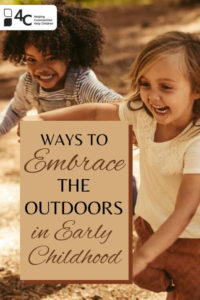
June 2022 – Published by 4-C
Nature captures our attention in new and exciting ways that can lead to adventure, especially for young children. Outdoor walks can be a new opportunity for children to learn about the natural world in their own creative ways. In fact, a short walk just around the block can lead to a whole adventure for a child as there is always something new to explore. This is great for childhood development as it will allow them to fully embrace their senses. The wind blowing in their face, touching the sand with their feet and wiggling their toes to feel the texture and observing animals in their natural habitat – this type of attention is called involuntary attention, which allows voluntary attention some time to rest.
Learning while outdoors can be immersive and exciting, and has the ability to activate all of the senses. Children who spend regular time outdoors get a variety of benefits that can lead to more creativity and better learning in the classroom. They get more motivation, an increase in confidence and cooperation and can develop connections to places and home.
Here are a few ways to give your child a new exciting opportunity each day:
The Weather
Rain, clouds, or shine, there are multiple ways to take advantage of the elements around you
- Encourage your child to play with their shadow
- Take a magnifying glass and inspect raindrops
- Look at the clouds and point out what they might look like
- Put on your galoshes and go puddle-jumping after or even while it’s raining
Animals
Dogs, cats, rabbits, birds, frogs, worms, ants…there are so many animals and insects to see
- While out on a walk or during time spent on the playground, have children point out how many animals they can see
- Watch how certain insects or bugs move and try to mimic their behavior
- Try to chirp like the birds you hear
- Name the colors of dogs, butterflies, and birds and talk about their different markings
Plants
Flowers, grasses, weeds, trees, and more…explore what grows in your neighborhood
- Encourage the children to inspect different plants you see while outside
- Show them how certain flowers are fragrant, while others don’t produce a smell
- Go on a color hunt and try to find something natural for every color of the rainbow
- Compare the differences between leaves on the trees you pass
We often pass by a lot of the world as our daily lives might become routine, but to our children everything is new. It’s important for them to pick up rocks and see how one is different from the other, to listen carefully to the sound of the wind rustling through the leaves of a tree, and to feel the splash of raindrops on their skin. Find and connect with your child on the beauty our world offers.
But when and where can we find the time to explore the outdoors?
School Commute
- For those that live close to school or child care, try to walk or ride your bikes together instead of driving or taking the bus
- If you live too far to walk, take the time when you’re in the car or on the bus to look out of the windows and discuss what you see, smell, and hear
Neighborhood Walks
- Try to build a daily or weekly walk into your schedule
- Leave the screens at home or in your pocket and practice embracing your senses and describing what you see, smell, feel, hear, and even taste (if it’s safe to consume)
- Use this opportunity to talk about walking safety, traffic rules, and point out who in the neighborhood is a safe person to approach if your child or children are ever lost or need help
Field Trips
- Field trips are an amazing way to explore new landscapes and discover unique plants, insects, and animals
- Try to identify the differences between what you see on your trip verses what grows or crawls in your yard
- Listen to the sounds of nature and talk about how much louder or quieter it is than what you’re used to hearing
Indoors
- Even when you can’t go puddle-stomping or sledding after a fresh snowfall, you can enjoy nature by looking out of the window
- Try taking a moment at different times of day and in different places – at home, in the car, or in stores – to look out of the window and discuss what you see
- If possible, try bringing the outdoors inside! Take scoops of snow from the yard and fill up a bucket for some sensory play, bring in leaves from a nature walk to do crayon rubbings, or use small rocks as part of your loose parts area
For child care providers or teachers, there are many benefits that come from outdoor learning. According to SHAPE America, children aged 3-5 should be engaged in 60 minutes of structured physical activity and 60 minutes of unstructured physical activity per day. Incorporating uninterrupted periods of outdoor time can help you meet this goal and encourage the children in your care come to appreciate the wonders of our natural world.
Resources:
- SHAPE America: Society of Health and Physical Educators
- NAEYC: Nature and the Outdoors
- Wisconsin DPI: Taking Education Outdoors
- 4-C Pinterest Board: Outdoor Learning

